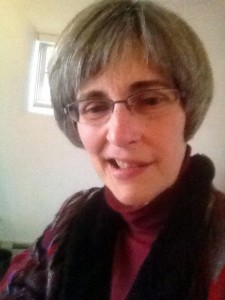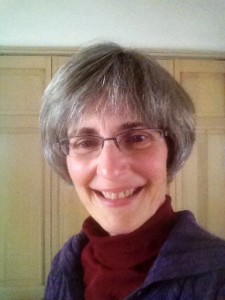The facial paralysis arrived overnight and crept away stealthily. Though my case was quite severe—nearly complete paralysis on the left side—in only two and a half weeks my face had healed to the point of a normal smile; the impairment was invisible. (Full healing took some weeks longer.)
Since Bell’s palsy is so common—and mysterious—and since my bout of it was so short compared to many, I want to let others know a few things that helped.
Let me preface it by saying that I did not take either steroids or antivirals, the medications that are often prescribed. I wanted to avoid both, so I did.
Here are some things that helped in my healing process, in no particular order:
1. A soothing atmosphere. Early on, a friend with experience in treating nerve damage recommended that I go toward anything soothing or relaxing. I found that I did need more peace and quiet than usual, in part because the facial nerve feeds a small bone in the inner ear that modulates loud sharp sounds. When that bone was out of commission every loud sound, even low ones, came across as a high shriek that stabbed like a knife. I work from home so didn’t have to battle traffic noise except while taking Bodhi for his afternoon walks, and then I often wore earplugs. And stayed happier!
2. Massage. Upper-body massages felt soothing and relaxing, plus they loosened muscles in neck and shoulders that had tightened against the injury. I got a professional massage once a week, plus I massaged and manipulated the face muscles many times each day. Gently, of course. Just to give them some enjoyable motion and help them remember how to move. My massage therapist suggested that the full benefits of a massage may only show up a day or two afterward. I noticed that about forty-eight hours after each professional massage, face and lip muscles took a big jump forward toward healing. Oh, and I gave myself full head and foot massages every day. Just because it felt good.
3. Breathing. When a part of the body is impaired, we tense up against it, which means we tighten muscles against the free flow of rejuvenating blood. I found it extremely hard to keep breathing normally through the headaches and eye pain and impaired vision that came with Bell’s palsy. I took ibuprofen a couple of times when the headaches were at their worst, but more often I stopped to breathe deeply. Anything that opens the breath will aid physical healing, since being able to fully breathe bathes each part of the body in fresh, life-giving nutrients. I took many time-outs each day to take a few extra deep breaths.
4. Easy breath-based exercise, especially cross-side movements. During the nerve injury I needed to modify my yoga practice. Head-down positions caused an instant congestion in the skull that felt like the opposite of healing, so I temporarily stopped all upside-down positions, even quick downward dogs. Instead, I focused on easy breath-based motions. My favorite was a modified abdominal crunch, which I’d just learned in a yoga class a month or so before:
Lying on the back, knees bent, feet flat on the floor, interlace the fingers behind the neck or head. Breathe in and allow the back area at the waist to lift off the floor as you do. Inhale fully with the spine arched. Then breathe out and allow the spine to roll gently to the floor while the head and shoulders rise gently up. Keep up an easy rhythm, focusing on a full, slow inhale and a full, slow exhale while the spine area near the kidneys rolls gently up off the floor and down again.
And here’s the cross-side or easy-twist variation:
Breathe in while the spine area at the waist rises off the floor. Breathe out, leaving the left elbow resting lightly on the floor. Raise the head, shoulders, and right elbow, and touch the right elbow to the left knee. Exhale completely. Breathe in, returning head and shoulders to the floor and lifting the spine in an arch. Breathe out, raising the left elbow to the right knee.
Easy twists and cross-side motions of all kinds felt helpful, especially when done slowly, soothingly, in time with the breath. Nothing else left me quite so refreshed. (They felt much more refreshing during Bell’s palsy than they usually do.)
5. A healing mind-set. With Bell’s palsy I became hypersensitive to disharmony and needed peaceful surroundings. Two mind-sets were particularly helpful to healing: joy and gentleness.
Joy. “Laughter is the best medicine” is not just folk wisdom. Research supports the healing power of joyfulness. I find that joy lives at the heart of nature, so during Bell’s palsy I kept going by meditating on nature. Every day I visited favorite nature places in memory and soaked up some of their magic. I love the healing power of the desert where I live, but it’s austere, and during this bout with a damaged nerve I found that landscapes bursting with green life-force felt more rejuvenating. I revisited damp hiking trails winding through thickly teeming tropical forests on Maui; I renewed my love for two enormous mossy coastal oaks on spring-green hills near Mt. Tamalpais. I visited in memory every favorite place I could think of, and then I thought of some more places and visited them too. Each scene imparted a feeling of happiness, and every moment of happiness opened the breath and worked some revitalizing magic. If joy is the wellspring of healing, then I drank deep. Every day.
Gentleness. My Bell’s palsy took place during the darkest time of year, so I went with the flow of the season and cultivated gentleness. I treated myself like an infant, regarding my injury with tender kindness. I took naps when needed. I made friends with the quiet I needed for healing, remembering how much, as a child, I loved to simply sit quietly and look at things or listen to the gentle sound of breeze through tree leaves. I found a piece of music that took my mind to that sweet, gentle place, and I listened to it over and over. Other people might need upbeat music for healing, but for me this time, gentleness was the ticket.
6. Healing supplements. Research shows that omega-3 fatty acids support nerve regeneration, so I took 2 tablespoons of fish oil every day for a couple of weeks. I don’t have any results to report except that the emulsified, fruit-flavored kinds taste yummy.
7. Eye pillow. Bell’s palsy often prevents the affected eye from closing completely, leading to dry eye and pain and possibly impaired vision. I slept on my back and placed an eye pillow over my eyes. It added just enough pressure to keep the left eye closed during the night. Keeping the eye moist during the day was a different challenge, one I never figured out.
8. Enjoying myself as I am. We often call it “self-acceptance,” but I discovered that the truly healing mind-set is more active than that. Healing resides not just in accepting oneself but in enjoying oneself. Enjoying the “how” of oneself. Enjoying how one is. Enjoying how one goes through life.
I made peace with my lopsided face when, during the first week of paralysis, full of trepidation, I decided to go to the nature center anyway and cover my usual shift behind the counter. Visitors came and went—a record number that day—and though I could feel my ragged mouth hanging open when I laughed and talked with them, no one seemed to notice. If they did, they were kind enough not to register it.
But Bell’s palsy offered a chance to make peace with the self at deeper levels too, and for me this had something to do with claiming solitude. Other people may find that conversation and company rejuvenate them best, but for me at this time, solitude and silence were key. And as I slipped finally into enjoying them, solitude and silence brought a new reality to life. At the end of several weeks I felt like a door had been knocked open inside me to a finished basement I didn’t know I had, and that deep refuge of silence was warmly welcoming. Claiming and enjoying “how you are” in life, however you are, works magic.
So how am I now? All healed up, as far as I can tell. The healing began during the first week with a few tiny muscle twitches in one part of my lip and then, the following day, a millimeter of movement in that same spot. During the second week my face was raging with muscle tics—in the lip, in the eyebrow or eyelid, in the cheek—and after each one came a piece of restored movement. Two and a half weeks after onset, my smile was again normal and the nerve injury was invisible.
Now, about six weeks after onset, I find a tiny muscle twitch still happens here or there, and I welcome it, knowing that a final millimeter or two of micromuscle is coming back to life. My hearing is normal again too. I am grateful beyond words for how quick this trip was to the underworld of injury and illness.
Like many trips to the underworld, this one brought its gifts. I loved the deep inner silence that became available while I was sick. I’ve had a lot more trouble finding my way back to it since I am well. I forget to visit the joyful places too when my daily need is not so great. But I feel lucky to be well again.
Healing is a gift. Healing is always a gift. We don’t make it happen, we don’t manifest it, we don’t manufacture it. The world is not a machine that we can regulate with our acts.
But we can make the space for healing to happen. Doing things to promote healing is like cleaning out the rooms and rearranging the furniture so healing can move in. Without some freshly empty space, healing might be tempted to just walk on by. And though making space doesn’t guarantee a cure, it does ensure that your life will be more spacious, with more room for something new.
Wishing you healing in body and spaciousness in spirit during this new year.

